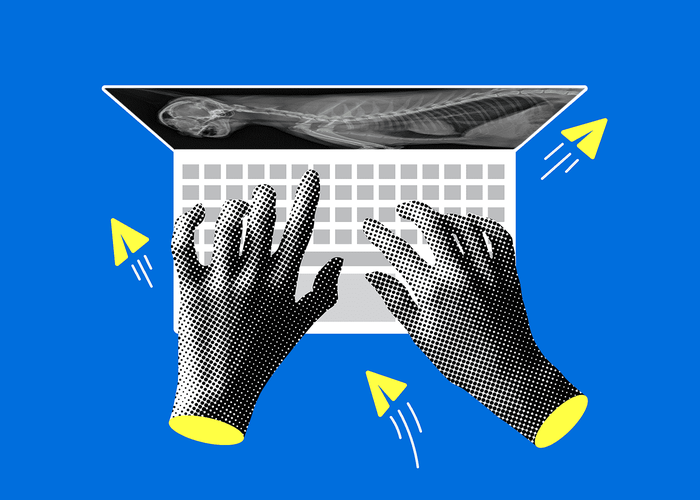

Best Practices for Veterinary X-Rays: How to Boost Diagnostic Accuracy
Radiography is an accessible imaging technique that can provide indispensable diagnostic information in the veterinary practice. High-quality X-rays enable veterinarians to diagnose and formulate effective treatment plans, ultimately improving patient outcomes.
That said, veterinary teams must thoroughly understand radiographic principles and safe patient-handling techniques to obtain diagnostic-quality radiographs. Here's a refresher on some tips and strategies to help optimize X-ray quality and radiation safety in your veterinary practice.
The Importance of High-Quality X-Rays
X-ray systems are standard equipment in nearly all veterinary practices, making them one of the most easily accessible diagnostic modalities. Radiology is crucial for diagnosing and monitoring various conditions, such as fractures, gastrointestinal conditions, cancer metastasis, and more. Poor-quality radiographs can hinder accurate diagnoses and delay appropriate treatment.
Quality images provide a clear representation of the area of interest (AOI). Radiographs that lack clarity and detail or AOI distortion with artifacts can lead to missed or incorrect diagnoses. Additionally, poor X-ray quality necessitates retakes that increase the veterinary team's cumulative radiation exposure, hampering overall efficiency.
Optimizing Patient Positioning
Proper patient positioning is a critical factor for quality X-rays. Pets must remain still to minimize motion blur and technicians must ensure the AOI is as close to the tabletop as possible to reduce distortions. Without proper positioning and restraint, a confident diagnosis may not be possible and require a retake.
Sedation should be considered for stressed or excited pets or for certain orthopedic studies that require awkward and sometimes painful positioning. Positioning aids, including foam pads, sandbags, and tape, can help stabilize the patient and reduce team members' radiation exposure by allowing them to step away while capturing images (Recommended to be at least 6 inches away). Always collimate (i.e., narrow the X-ray beam) to include only the AOI and nearby landmarks, and don't forget to add markers to indicate patient laterality.
Adjusting Exposure Settings
Exposure settings, including kilovoltage peak (kVp) and milliampere-seconds (mAs), determine the image detail, contrast, and clarity and control the X-ray energy power and amount delivered to the AOI. Over- or under-exposed images lack detail and obscure or exclude anatomy, which renders them non-diagnostic.
All practice team members should follow the technique chart for their specific X-ray system, which details kVp and mAs settings for varying patient sizes and tissue densities. Once an initial image is obtained, adjust as needed to refine the quality. If the image is too dark, try decreasing the mAs or kVp. Conversely, if the image is too light, increase mAs or kVp.
Controlling Artifacts
External objects, such as collars and tags, or positioning aids that are visible on the X-ray can sometimes obscure the AOI. Always remove the pet's clothing and gear before imaging. Also, be mindful of the patient's position on a pad or trough, because a positioning aid's edge can leave a line across the film. Team members should try to center the AOI over the aid.
Proper positioning and collimation reduce the likelihood of artifacts, improve image quality, and enhance team member safety by reducing X-ray scatter. Team members should determine how much to collimate the beam with established landmarks—for example, including the joint proximal and distal to a long bone in the view. If the full area doesn't fit on a single view, take two overlapping images.
Using X-Rays and Telemedicine
X-ray image quality is of particular importance when the attending veterinarian is sending studies for a secondary radiologist review. Teams should strive to meet referral-level imaging standards for all in-practice X-rays, which helps establish consistency. This is one reason it's beneficial to work with teleradiologists. Feedback from teleradiologists can play a valuable role in improving imaging protocols and quality expectations, as radiologists often score the imaging to contextualize their reports (something AI radiology does not do). The poorer the image, the less certain the diagnosis.
Training and Educating the Team
Onboarding should always include X-ray safety training to ensure everyone working near the equipment understands basic radiation risks and safety. As with any clinical skill, ongoing education is essential to help veterinary technicians and assistants master radiographic safety, positioning, and techniques. Credentialed technicians, who learn radiographic principles, techniques, and troubleshooting skills during their formal education, are valuable resources for the rest of the team.
Continuing education courses, wet labs, workshops, and webinars can teach non-credentialed team members imaging basics and help keep skills honed and knowledge fresh. As the medical leaders in a clinic, veterinarians should periodically refresh their training on imaging principles to help troubleshoot difficult views and refine their image interpretation skills.
High-quality images are a necessity in veterinary medicine. The widespread availability of telemedicine and radiologist feedback can help leadership improve the teams imaging weaknesses. Educating veterinary team members on basic X-ray principles will result in better images with fewer retakes, increasing team member safety, ensuring helpful reports, and improving patient treatment outcomes.







